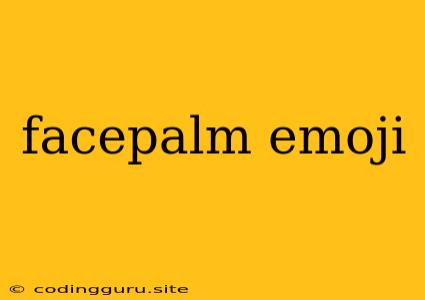The "Facepalm" Emoji: A Universal Symbol of Frustration and Disbelief
Have you ever felt so utterly defeated by something so incredibly obvious or stupid that you just wanted to bury your face in your hands? Well, you're not alone. The "facepalm" emoji ( 🤦♂️ ) is a universally recognized symbol of frustration, disbelief, and the overwhelming urge to smack your forehead in annoyance.
But what makes this emoji so effective? Why is it so relatable? Let's delve into the origins and evolution of the "facepalm" emoji and explore its various interpretations across different cultures and contexts.
Origins and Evolution
The "facepalm" emoji, officially known as the "Person Facepalming," is relatively new to the emoji scene. It was first introduced in Unicode 9.0 in 2016, making it a member of the "Generation Z" of emojis. While its digital roots are recent, the gesture it represents is as old as time.
Think about it. Have you ever seen a cartoon character smack their forehead in exasperation? The "facepalm" gesture is an archetypal representation of frustration and disbelief, deeply ingrained in our understanding of human emotion.
The Power of Context: What Makes the "Facepalm" Emoji So Versatile?
The "facepalm" emoji's versatility lies in its ability to convey a wide range of emotions and sentiments, all while maintaining its core meaning of frustration and disbelief.
Here are a few scenarios where the "facepalm" emoji is most commonly used:
- When someone does something incredibly stupid: "I can't believe you forgot to lock the door! 🤦♂️"
- When someone fails miserably: "He missed the easiest shot! 🤦♂️"
- When someone says something incredibly obvious or naive: "The sky is blue? 🤦♂️"
- When you are the one doing something stupid: "I just realized I left my phone at home... 🤦♂️"
The "Facepalm" Emoji Goes Global: Cross-Cultural Understanding
The "facepalm" emoji transcends cultural barriers, becoming a universally understood symbol of frustration. Even if someone doesn't speak your language, they can still comprehend the meaning behind the "facepalm" emoji.
This cross-cultural understanding highlights the power of nonverbal communication and the ability of emojis to transcend linguistic boundaries.
The "Facepalm" Emoji: More Than Just a Simple Gesture
While the "facepalm" emoji is often used to express frustration and disbelief, it can also be used in a humorous context. Think of it as a playful way of acknowledging a funny or awkward situation.
Sometimes, the "facepalm" emoji can even be used as a way of self-deprecating humor. It can be a way of admitting that you've made a mistake or done something foolish.
The "Facepalm" Emoji: A Modern-Day Expression of Human Emotion
The "facepalm" emoji is more than just a funny little picture. It is a powerful tool that allows us to express a wide range of emotions, from frustration and disbelief to amusement and self-deprecation.
As technology continues to evolve, so too will the "facepalm" emoji, taking on new meanings and interpretations. However, one thing will remain constant: the "facepalm" emoji will always be a symbol of the human experience, a way to express the frustration, disbelief, and humor that is an integral part of our lives.
Conclusion
The "facepalm" emoji has become an essential part of our online vocabulary, a powerful tool for expressing frustration, disbelief, and even humor. It's a versatile symbol that transcends cultural boundaries, uniting us through shared experiences of human emotion.
Whether you're using it to express your annoyance at a friend's bad joke or acknowledging your own blunder, the "facepalm" emoji is a testament to the power of nonverbal communication and the human need to express ourselves, even in the digital realm.
